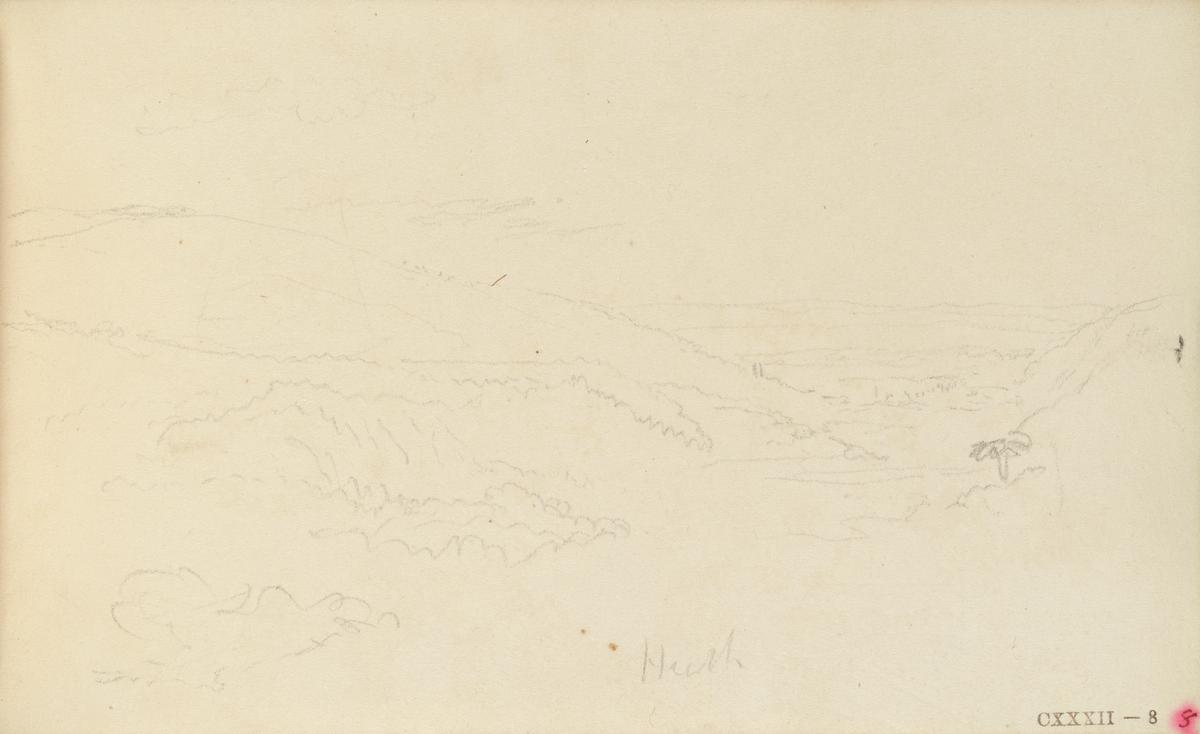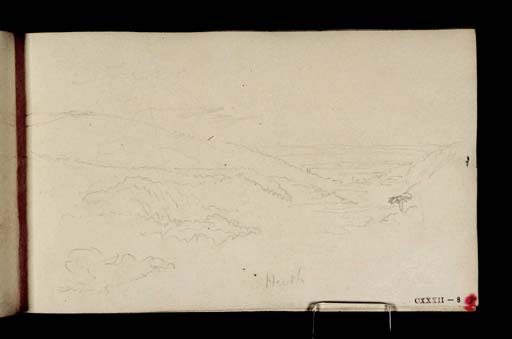Joseph Mallord William Turner Moorland, Possibly on or near Dartmoor 1814
Image 1 of 2
Joseph Mallord William Turner,
Moorland, Possibly on or near Dartmoor
1814
Joseph Mallord William Turner 1775–1851
Folio 8 Recto:
Moorland, Possibly on or near Dartmoor 1814
D09489
Turner Bequest CXXXII 8
Turner Bequest CXXXII 8
Pencil on white wove paper, 90 x 152 mm
Part watermark ‘Iv’
Inscribed by Turner in pencil ‘Heath’ bottom centre
Inscribed by John Ruskin in red ink ‘8’ bottom right
Stamped in black ‘CXXXII – 8’ bottom right
Part watermark ‘Iv’
Inscribed by Turner in pencil ‘Heath’ bottom centre
Inscribed by John Ruskin in red ink ‘8’ bottom right
Stamped in black ‘CXXXII – 8’ bottom right
Accepted by the nation as part of the Turner Bequest 1856
References
1909
A.J. Finberg, A Complete Inventory of the Drawings of the Turner Bequest, London 1909, vol.I, p.372, CXXXII 8, as ‘“Heath” with river (or sea) in distance’.
Dartmoor, now a National Park, is roughly twenty miles across in all directions, and forms the core of the interior of south Devon with its moorland and granite outcrops known as tors. To this day it remains largely undeveloped, with only two roads traversing it entirely, crossing each other at Two Bridges near Princetown Prison, and villages and hamlets are largely restricted to sectors towards its eastern and western boundaries. Various rivers have their sources among the hills, including the East Dart and West Dart in the south-east, the East Okement and West Okement in the north-west, and the Tavy in the west.
To the casual observer the similarity of much of the terrain makes Turner’s views difficult to identify, and the topography of many of his views of apparently barren, undulating hills remains obscure as yet, except in the few cases where he added annotations. It is unclear whether he crossed Dartmoor completely at some stage, or (perhaps more likely) ventured onto it incidentally at various points near the places he visited around its fringes such as Okehampton, Lydford, Tavistock, Ivybridge and Buckfastleigh (see the Introductions to this sketchbook and the 1814 tour in general).
Drawings definitely or probably showing Dartmoor near the beginning of the sketchbook are on folios 10 recto and verso, 11 recto, 14 recto, 15 recto, 18 recto, 19 recto and verso, 20 recto, 21 recto, 22 recto, 23 recto, 24 recto, 25 recto and 26 recto (D09491, D40822, D09492, D09496, D09497, D09500, D09501, D41523, D09502–D09508). There are also various views towards the back, interspersed with views on the River Tamar (see under folio 114 verso; D09606), suggesting that some of the Dartmoor views may have been made nearby on the west side of the moors, although others show the south-eastern side; see folios 115 verso, 119 verso, 126 verso, 131 verso, 132 recto, 133 recto, 134 verso and 136 verso (D09608, D09615, D09629, D09638, D09639, D09641, D09644, D09648). A view of Dartmoor notes from the viewpoint of the Tamar Valley is on folio 137 verso (D09650).
Verso:
Blank
Matthew Imms
June 2014
How to cite
Matthew Imms, ‘Moorland, Possibly on or near Dartmoor 1814 by Joseph Mallord William Turner’, catalogue entry, June 2014, in David Blayney Brown (ed.), J.M.W. Turner: Sketchbooks, Drawings and Watercolours, Tate Research Publication, September 2014, https://www


